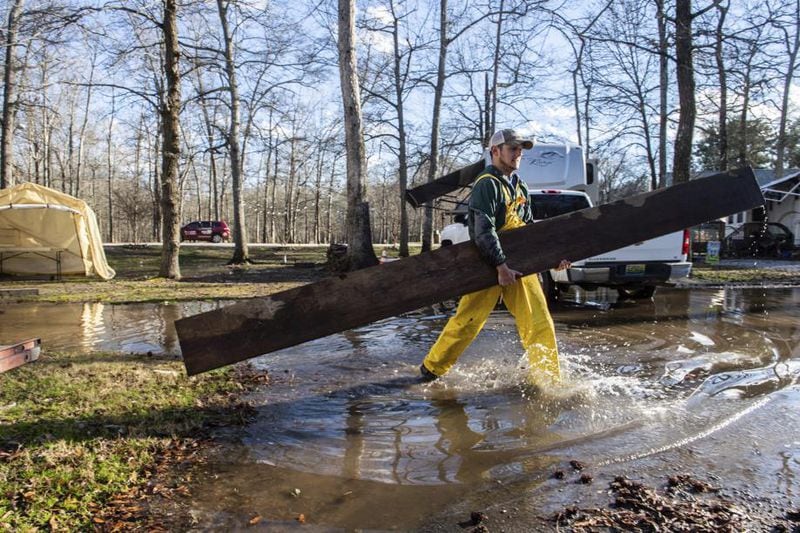A Tennessee hillside collapsed, roads were flooded and rivers were rising across the Southeast on Tuesday after a day of heavy rains that once again threatened a Mississippi lake where a dam previously was in danger of failing.
»RELATED: Teacher 1 of 2 killed in storms, tornadoes that ravaged the Deep South
The National Weather Service said minor to moderate flooding was expected from central Mississippi to North Georgia after downpours.
The Tennessee River was predicted to crest about 7 feet above flood level at Perryville, Tennessee, on Sunday.
Near Great Smoky Mountains National Park in eastern Tennessee, tons of rock and soil slid off a 70-foot hillside and blocked the northbound side of a U.S. 441 spur linking the tourist towns of Gatlinburg and Pigeon Forge, the National Park Service said.
At least 45 dump truck loads will be required to clear the road, officials estimated, but no injuries were reported.
Schools opened late or closed in parts of Alabama, Mississippi and Louisiana because of flash flooding. A flood watch stretched from eastern Texas to Mississippi, and parts of Alabama were under flood warnings.
North of Birmingham in Cullman, the sheriff’s office said Deputy Adam Clark and his police dog were badly injured in a wreck that occurred during heavy rains overnight. The cause of the crash was under investigation.
In eastern Mississippi, officials in Starkville said the water at Oktibbeha County Lake had once again reached a critical level just weeks after heavy rains caused a mudslide that put the earthen dam in danger of failing.
Pumps had been used to lower the lake level by about 8 feet since mid-January, but officials said the water had risen even higher than before because of recent storms.
“It has risen over 8.5 feet from our low elevation during pumping and continues to rise,” said a statement by Kristen Campanella, emergency management director in Oktibbeha County.
Officials also were monitoring the site of a potential dam failure in Yazoo County, where the Mississippi Emergency Management Agency said a 40-acre lake in a subdivision was leaking around a culvert and washing away dirt, threatening four homes and a church. Five homes were evacuated after a levee breach in Leake.
Elsewhere in Mississippi, 25 homes had been damaged and four people were hurt in wrecks caused by vehicles hydroplaning on wet roads, according to the state. The damage was worst in Yazoo, where a dozen people were displaced from homes.
The Tennessee Valley region has received 550% of its normal rainfall during the last seven days, James Everett, senior manager of the Tennessee Valley Authority’s River Forecast Center, said in a briefing. Rainfall averaged around 6 inches across the valley, but some places got as much as 9 inches.
“We're getting a brief break in rainfall today, but we expect it to pick up tomorrow through Thursday,” Everett said.
To manage all of the water, the TVA will continue storing water in large mountain reservoirs to help reduce flooding downstream, Everett said. The agency plans to adjust its strategy for water storage and flows depending on how much more water falls on the already-saturated ground, he said.
Isolated tornadoes and winds in excess of 60 mph are possible in some areas of the South after nightfall Wednesday, the National Weather Service said.
With the weather system moving eastward, West Virginia Gov. Jim Justice instructed emergency officials to be ready for flooding in addition to high water that already had led to school closures in the state.






